
Classic Buses Profiles
East Kent Dennis Lancets (by Dick Gilbert)
Last updated 17 October 2022
SOME LINKS WITHIN THIS WEBSITE:
Home
Email
Links
THE COMPLETE WEBSITE MENU
Events Diary
Halfcab list
Small-Ads
Classic Irish Buses
Classic Manx Buses

This page is a profile of the extensive fleet of Dennis Lancet single-decker buses and coaches that
East Kent operated both before and after the war.
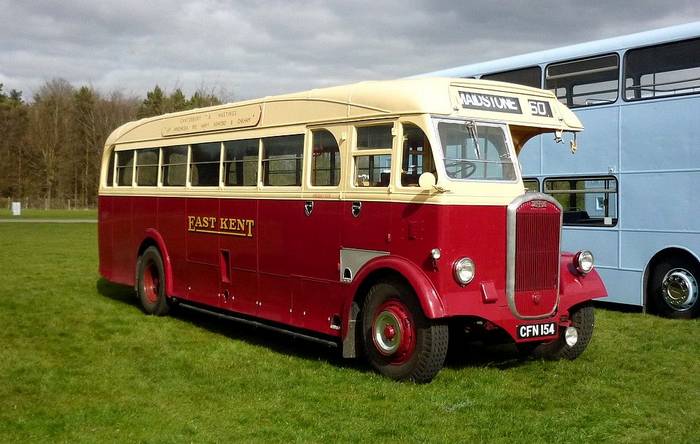
A typical example of the post-war Park Royal-bodied Dennis Lancet bus as used by East Kent. Basic
and functional, the design remained essentially unchanged from its pre-war ancestors, and buses like this could be seen all over
Kent for nearly 25 years. CFN 154 has been beautifully preserved, and is seen here attending the Maidstone and District and East
Kent bus club 60th anniversary rally at Detling in April 2012. Photo by Dick Gilbert.
INTRODUCTION AND CREDITS
East Kent Road Car Company Ltd. purchased more than 160 Dennis Lancets over two decades. Although
they appeared as buses and coaches, the largest number - and the most instantly recogniseable - were the single deck buses with
bodies built by Park Royal. What follows is an attempt to create a brief history of the type, in the form of records and images
designed to give even the casual reader some impression of the development and styling of this extensive fleet.
The East Kent Road Car Company was born in 1916, as a merger between five smaller companies who
were struggling to recover from the difficulties of operating in the wake of the first world war. As well as regular bus services,
coach excursions were being operated by the end of the decade.
The struggle against many small operators in the area was resolved in the 1930s, during which a
large number of local firms were absorbed into the company. By the late 1930s a substantial fleet of Leyland Tiger and Dennis
Lancet buses and coaches had been acquired, and an extensive network of operations took these distinctive bright red vehicles all
over Kent, and on express services outside the area and to London.
During World War II coach operations came to an abrupt halt, with some vehicles being required for
military service, and twenty four Leyland Tiger coaches being converted to ambulances. However, express coach services to London
were re-introduced in 1946, and newer post-war examples of the Lancet and the Tiger were acquired to operate these (and other)
services, and to substitute for vehicles from the 1930s that needed replacement, or for those that had not survived the
hostilities.
The 1950s were a busy time for these machines, but by 1960 the halfcab psv was considered a thing
of the past. Few pre-war vehicles were still operating and the post-war acquisitions were sold off to other operators around the
country, although some coaches were demoted to bus work and continued in service for a few years, sometimes involving
considerable modification.
The rear-entrance Lancet with its separate cab was not suitable for One-Man-Operated services, and
24 of them from the CFN batch were modified in 1959. The cabin floor was lowered by nearly 12 inches to enable the driver to
enter the saloon, the radiator block was shortened by 6 inches to permit the lower edge of the windscreen to be deepened, and the
drivers' pedals and steering column were all moved to accommodate the new arrangement. Chassis strengthening was also required at
the front to support the new structure, and a complete new front end was built on to the body. The result would have provided a
decidedly modern appearance at the time, not least because it got away from the traditional halfcab design that had hardly
changed for more than 25 years.

A line of East Kent single deckers awaiting disposal in the 1960s. In the middle are two of the
1939 Lancet IIs (AJG 44 and AJG 42) with the roof panniers for band instruments. On the left is AJG 46, one of the identical
Lancets but without the roof boxes. On the right is a Leyland Tiger, but I'm not sure which one. Garth Wyver suggests that it
might be JG 6503, a 1935 Tiger TS7 which had its original Park Royal coach body destroyed in an air raid and was fitted with a
replacement Burlingham utility bus body in 1943. That's very possible. Photo unknown.
By the end of the 1960s all the classic Lancets had gone (the last one being CFN 117, withdrawn in
the summer of 1969) and bus and coach services were being severely hit by the popularity of the family car. New equipment had
been placed into service to replace the halfcab fleet, mostly based on the popular AEC Reliance chassis. We are fortunate to have
a few Lancet survivors today. The stunning scarlet East Kent coaches are now only seen in preservation, and the company name was
extinguished by Stagecoach.
All batches are arranged in order of delivery, but I have not included the later Dennis Lancet UF
underfloor-engined models.
Owners of pictures, when known, are credited, and their use is much appreciated. However the
photographers of some pictures are not shown on the original, and therefore are not known to me. Whoever they were I thank them,
and if they contact me with their names they will of course be credited. If a rightful owner (or copyright holder) wishes me to
remove any image, it will be done forthwith. However I hope that photographers (or copyright holders) will permit the use of
these fine pictures in their proper context.
As with my other lists, there are bound to be mistakes, and some relevant information may be
missing so, in order to make it as accurate a reference as possible, I would of course welcome any additions or corrections.
FLEET LIST
=============
DENNIS LANCET BUSES - JG 6800-6824 (total 25)
Delivered: 1936
Chassis: Dennis Lancet (JG 6823 and 6824 were Lancet II with Gardner 5-cylinder oil engines and the
updated design of Lancet radiator grille). Dennis D3 petrol engines, changed to Dennis 4-cylinder 'O' Type oil engines in 1937/38.
Body: Dennis B35R. Ten were rebodied with older (1934) Park Royal B34R half-canopy bodies in
1947-49.
Notes: Glynn Thomas kindly advised me as follows: "Orders and correspondence in the Dennis
specialist vehicle archives, held by the Surrey history centre, show that JG 7808 was fitted with the very first of the newly-
designed Dennis O4 diesel engines (engine number 100 001 001) so never had a petrol engine. It is also apparent from the
correspondence in these archives that the orders for JG 6823 and JG 6824 were amended by East Kent to have Gardner 5LW engines
fitted (so having to be Lancet IIs) in order to trial these engines against the new Dennis diesel engine in JG 7808. The 25
vehicle order for what became JG 8702 to JG 8725 (initially ordered in 1935) was put on hold while these engines were evaluated,
hence JG 8702 to JG 8725 were not built until 1937, and JG 7808 was effectively the first of that 1935 order of 25."
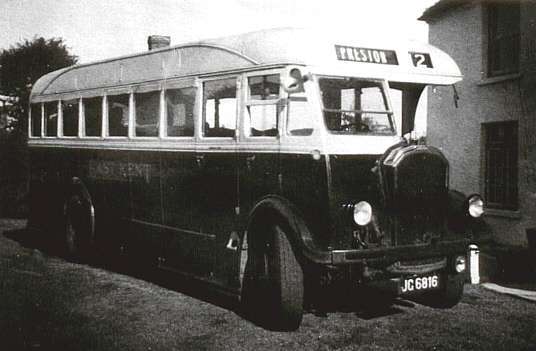
JG 6816 on route 12. Photo: M.and D. and East Kent bus club.
- JG 6800. Fitted in 1949 with 1934 Park Royal B33R body from 1928 Tilling-Stevens B10 FN 9001.
- JG 6801. Retained its Dennis body post-war. With Scott-Hale (contractor), Hornchurch in 1958.
- JG 6802.
- JG 6803. Retained its Dennis body post-war.
- JG 6804. Retained its Dennis body post-war.
- JG 6805. Retained its Dennis body post-war.
- JG 6806. Fitted in 1949 with 1934 Park Royal B33R body from 1928 Tilling-Stevens B10 FN 9004.
- JG 6807. Fitted in 1949 with 1934 Park Royal B34R body from 1928 Tilling-Stevens B10 FN 9006.
- JG 6808. Fitted in 1949 with 1934 Park Royal B33R body from 1928 Tilling-Stevens B10 FN 9002. Loaned to Aldershot and District 1940-43. Withdrawn 1954, sold to G.H.Groves (dealer), London.
- JG 6809. Built 4/36, c/n 171114. Fitted in 9/49 with 1934 Park Royal {B3466} B34R body from May 1928 Tilling-Stevens B10 FN 9008 (c/n 5635). Withdrawn in 1954, later adapted to accommodate wheelchairs. In preservation by East & Mid-Kent Preservation Society in 1967, restored and rallying by 1968. Owned by D.Weaver, Hull from 1974 but scrapped around 1987.
- JG 6810. Retained its Dennis body post-war.
- JG 6811. Fitted in 1949 with 1934 Park Royal B33R body from 1928 Tilling-Stevens B10 FN 9005. Later used as a tourism publicity bus for Ramsgate.
- JG 6812. Retained its Dennis body post-war.
- JG 6813. Retained its Dennis body post-war.
- JG 6814. Retained its Dennis body post-war.
- JG 6815. Retained its Dennis body post-war.
- JG 6816.
- JG 6817. Retained its Dennis body post-war.
- JG 6818. Retained its Dennis body post-war.
- JG 6819. Fitted in 1949 with 1934 Park Royal B33R body from 1928 Tilling-Stevens B10 FN 9003.
- JG 6820. Retained its Dennis body post-war.
- JG 6821. Retained its Dennis body post-war.
- JG 6822, Fitted in 1949 with 1934 Park Royal B34R body from May 1928 Tilling-Stevens B10 FN 9010 (c/n 5637).
- JG 6823 (Lancet II with Gardner 5LW engines - see notes above) Fitted in 1949 with 1934 Park Royal B34R body from May 1928 Tilling-Stevens B10 FN 9011 (c/n 5638).
- JG 6824 (Lancet II with Gardner 5LW engines - see notes above) Fitted in 1949 with 1934 Park Royal B33R body from May 1928 Tilling-Stevens B10 FN 9016 (c/n 5643).
DENNIS LANCET II BUS - JG 7808 (total 1)
Delivered 1936
Chassis: Dennis Lancet II.
Body: Dennis B35R.
Notes: Glynn Thomas kindly advised me as follows: "Orders and correspondence in the Dennis
specialist vehicle archives, held by the Surrey history centre, show that JG 7808 was fitted with the very first of the newly-
designed Dennis O4 diesel engines (engine number 100 001 001) so never had a petrol engine. It is also apparent from the
correspondence in these archives that the orders for JG 6823 and JG 6824 were amended by East Kent to have Gardner 5LW engines
fitted (so having to be Lancet IIs) in order to trial these engines against the new Dennis diesel engine in JG 7808. The 25
vehicle order for what became JG 8702 to JG 8725 (initially ordered in 1935) was put on hold while these engines were evaluated,
hence JG 8702 to JG 8725 were not built until 1937, and JG 7808 was effectively the first of that 1935 order of 25."
- JG 7808. Destroyed in air raid at Canterbury depot 31 May 1942.
DENNIS LANCET II BUSES - JG 8702-8725 (total 24)
Delivered 1937
Chassis: Dennis Lancet II, 4-cylinder engines.
Body: Dennis B35R. Various modifications and repairs were made as a result of war damage, and the
twelve best vehicles were rebodied by Park Royal as B35R in 1949.
Notes: All withdrawn by 1961.
Notes: Glynn Thomas kindly advised me as follows: "Orders and correspondence in the Dennis
specialist vehicle archives, held by the Surrey history centre, show that JG 7808 was fitted with the very first of the newly-
designed Dennis O4 diesel engines (engine number 100 001 001) so never had a petrol engine. It is also apparent from the
correspondence in these archives that the orders for JG 6823 and JG 6824 were amended by East Kent to have Gardner 5LW engines
fitted (so having to be Lancet IIs) in order to trial these engines against the new Dennis diesel engine in JG 7808. The 25
vehicle order for what became JG 8702 to JG 8725 (initially ordered in 1935) was put on hold while these engines were evaluated,
hence JG 8702 to JG 8725 were not built until 1937, and JG 7808 was effectively the first of that 1935 order of 25."
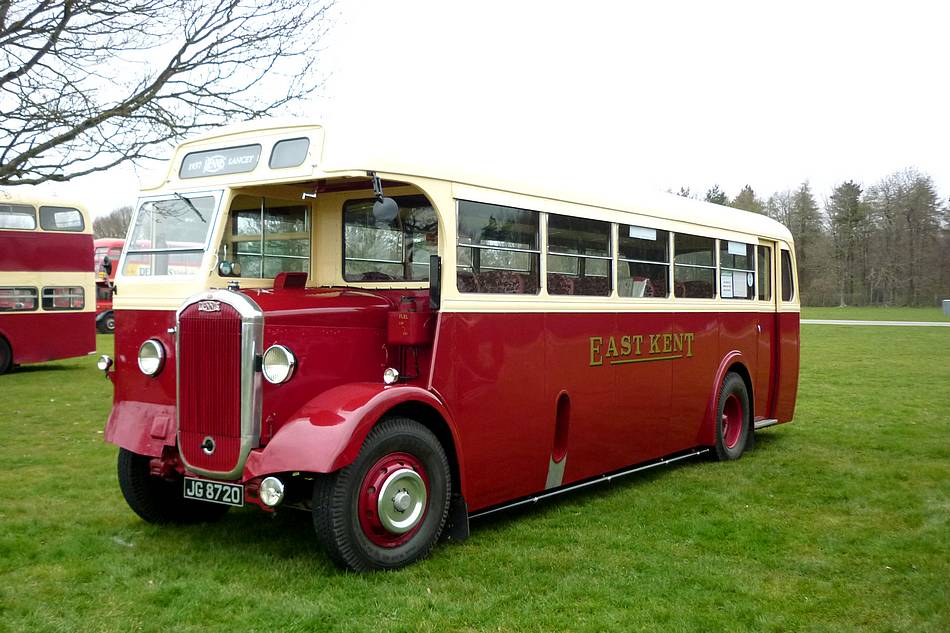
A very welcome survivor of this pre-war batch of East Kent buses is JG 8720 sporting its post-war
Park Royal body, and seen here at the Detling rally in April 2012. (Photo: Dick Gilbert)
- JG 8702 - Gone by 1956.
- JG 8703 - c/n 175275. New Park Royal B35R body No. B34032 fitted 10/49. In service 1956, gone by 1961.
- JG 8704 - Gone by 1956.
- JG 8705 - c/n 175277. New Park Royal B35R body No. B34025 fitted 9/49. In service 1956, gone by 1961.
- JG 8706 - Gone by 1956.
- JG 8707 - Gone by 1956.
- JG 8708 - c/n 175280. New Park Royal B35R body No. B34026 fitted 9/49. In service 1956, gone by 1961.
- JG 8709 - c/n 175281. New Park Royal B35R body No. B34027 fitted 9/49. In service 1956, gone by 1961.
- JG 8710 - c/n 175282. New Park Royal B35R body No. B34028 fitted 9/49. In service 1956, gone by 1961.
- JG 8711 - c/n 175283. New Park Royal B35R body No. B34030 fitted 9/49. In service 1956, gone by 1961.
- JG 8712 - c/n 175284. New Park Royal B35R body No. B34024 fitted 9/49. In service 1956, gone by 1961.
- JG 8713 - Gone by 1956.
- JG 8714 - Fitted in 1943 with a utility Burlingham UB36F body (original body destroyed in an air raid). Withdrawn by 1956. Became a lorry. Broken up c.1960 and lorry body transferred to utility Guy Arab BJG 421.
- JG 8715 - Gone by 1956.
- JG 8716 - Destroyed in air raid at Canterbury depot 31 May 1942.
- JG 8717 - Gone by 1950.
- JG 8718 - Destroyed in air raid at Canterbury depot 31 May 1942.
- JG 8719 - c/n 175219. New Park Royal B35R body No. B34036 fitted 12/49. In service 1956, gone by 1961.
- JG 8720 - Built 7/37, c/n 175292, P.R. body No. B34029 fitted 9/49. In service 1956, gone by 1961. **SURVIVOR**
- JG 8721 - Gone by 1956.
- JG 8722 - c/n 175294. New Park Royal B35R body No. B34035 fitted 12/49. In service 1956, gone by 1961.
- JG 8723 - c/n 175295. New Park Royal B35R body No. B34031 fitted 9/49. In service 1956, gone by 1961. Showman's vehicle in Gillingham 1962.
- JG 8724 - Gone by 1956.
- JG 8725 - c/n 175297. New Park Royal B35R body No. B34034 fitted 12/49. In service 1956, gone by 1961.
DENNIS LANCET II BUS - JG 9906 (total 1)
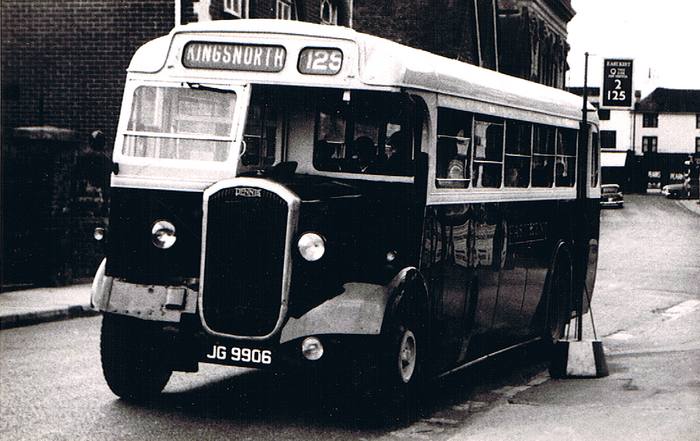
The one-off Lancet JG 9906 with its replacement Park Royal body, looking very smart in the 1950s
on route 125 to Kingsnorth. Garth Wyver says that that bus is standing in Marsh Street (now part of Station Street), Ashford,
with St. John's Baptist Church behind. Photo: unknown.
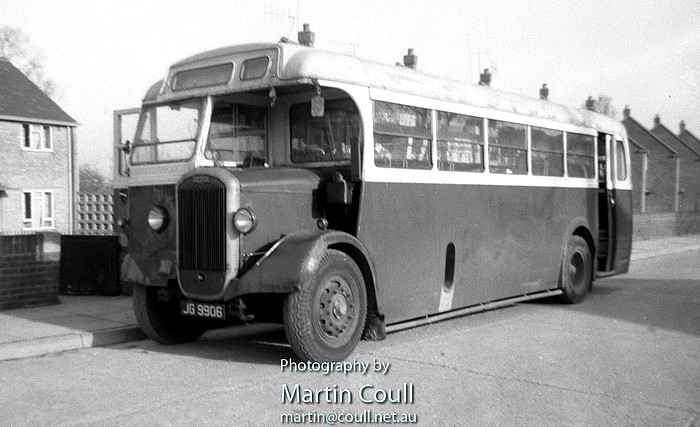
Martin Coull kindly sent me this picture. He said: "JG 9906 was used by a Grocer (Bruce's) in
Weeds Wood, Chatham for a few years until the shops were built in 1960. He had a regular round and was seen fully-loaded
travelling at a pace that a push-bike could overtake! This photo was taken on the day it was acquired by Bruce's. The seats were
pulled out by sundown! A note on the negative bag said 'June 59, Brownie 127, Ilford Selochrome ID11'." Photo: Martin Coull.
Delivered 1937
Chassis: Dennis Lancet II, 4-cylinder engine.
Body: Park Royal B35R. Received new Park Royal B35R body in 1949.
Notes: Exhibited at Earl's Court Show when new.
- JG 9906 - c/n 175388. New Park Royal B35R body No. B34033 fitted 12/49. Withdrawn 1959 and became mobile shop in Chatham.
DENNIS LANCET II BUSES - AJG 41-45 (total 5)
Delivered 1939.
Chassis: Dennis Lancet II.
Body: Park Royal B35R. Had full-length roof boxes to carry band instruments.
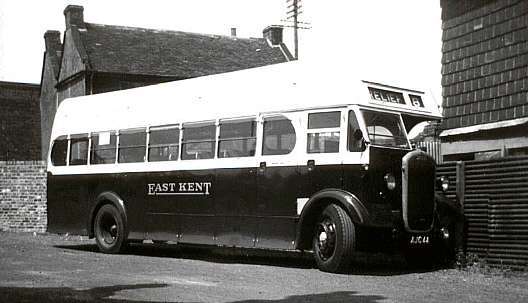
This photo of AJG 44 shows the strange appearance of the Lancets fitted with roof panniers. This
bus eventually retired happily into the sunshine, being sold to Cyprus in 1956. Photo: M. and D. and East Kent bus club.
- AJG 41 - Withdrawn by 1956
- AJG 42 - Withdrawn by 1956. To Demby's Reliable Transport Service.
- AJG 43 - Destroyed in air raid at Canterbury depot 31 May 1942.
- AJG 44 - c/n 175621, b/n B5350. Sold Jan 1956 to Lefkaritis, Larnaca, Cyprus, re-registered TW 40.
- AJG 45 - Withdrawn by 1956
DENNIS LANCET II BUSES - AJG 46-59 (total 14)
Delivered 1939
Chassis: Dennis Lancet II.
Body: Dennis B35R half-canopy.

Sadly this picture has not reproduced well, but the original shows the route for this Lancet as
no. 37 to Herne Bay. The vehicles behind look to be Maidstone and District, probably a Weymann-bodied Titan TD and a pre-war
Leyland Tiger/Harrington coach. The double decker appears to be on M and D route 3, which ran from Maidstone to Faversham. Garth
Wyver says "Lancet AJG 51 is at Court Street, Faversham next to the East Kent office. Nearby was a cafe where the bus crews had
their tea breaks. M and D buses waited as seen in the photo alongside the Fremlins brewery wall - Maidstone no. 3 and Gravesend
no. 26 also I think East Kent double decker no. 3 to Canterbury". Photo: M. and D. and East Kent bus club.
- AJG 46 - Withdrawn by 1956
- AJG 47 - Withdrawn by 1956. At S. Blackwell and Sons yard, Earls Colne in 1962 in derelict state.
- AJG 48 - Withdrawn by 1956
- AJG 49 - Withdrawn by 1956
- AJG 50 - Withdrawn by 1956
- AJG 51 - Withdrawn 1955.
- AJG 52 - Withdrawn by 1956
- AJG 53 - Withdrawn by 1956
- AJG 54 - Withdrawn by 1956
- AJG 55 - Withdrawn by 1956
- AJG 56 - Withdrawn by 1956
- AJG 57 - Withdrawn by 1956
- AJG 58 - Withdrawn by 1956
- AJG 59 - c/n 175644. Sold Jan 1956 to Lefkaritis, Larnaca, Cyprus, re-registered TX 424.
DENNIS LANCET III BUSES - CFN 110-169 (total 60)
Delivered 1947-49
Chassis: Dennis Lancet III J3, with Dennis 6-cylinder diesel engine.
Body: Park Royal B35R half-canopy, 27' 6" long. 24 were rebuilt in 1959 to a full-fronted design
with front entrance to enable one-man operation.
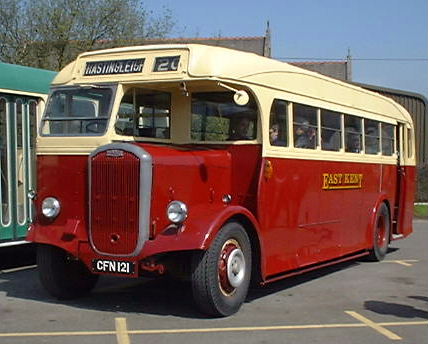
One of three survivors from this batch of post-war Dennis Lancets is CFN 121, seen here at the
Aldershot and District running day on 1 May 2000. Typical of East Kent is the unpretentious Park Royal bodywork. This example
still retains its original body, not having been modified for one-man-operated bus work. (Photo: Martin Smith)
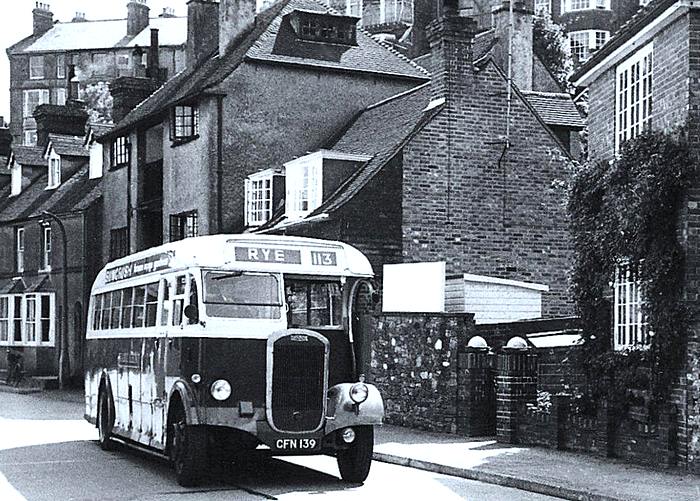
Dennis Lancet CFN 139 is seen in Rye in July 1960. Photo by kind permission of William Armstrong
via Chris Stanley
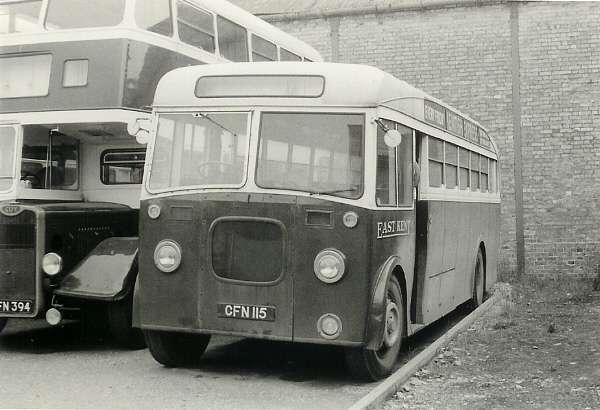
CFN 115 was one of the 24 from this batch modified to a full-front configuration in 1959. Here we
see it at Herne Bay garage on 4 June 1968 after it became one of the last to be withdrawn from service, and awaiting disposal,
probably for scrap. Photo by kind permission of Peter Esposito, via Chris Stanley.
Notes: The rear-entrance Lancet with its separate cab was not suitable for one-man-operated
services, and 24 of them from the CFN batch were modified in 1959. The cabin floor was lowered by nearly 12 inches to enable
the driver to enter the saloon, the radiator block was shortened by 6 inches to permit the lower edge of the windscreen to be
deepened, and the drivers' pedals and steering column were all moved to accommodate the new arrangement. Chassis strengthening
was also required at the front to support the new structure, and a complete new front end was built on to the body. The result
would have given a decidedly modern appearance at the time, not least because it got away from the traditional halfcab design
that had hardly changed for more than twenty five years.
CFN 110 was a 'one-off', delivered as a coach, some two years before the others.
- CFN 110 - Built 6/47, c/n 128J3, with Park Royal (presumably pre-war) body C32R No. B3465. Rebodied 7/49 with new Park Royal B32R body No. B33966. Sold c.1961. With Francis Bros., Tilehurst, Reading in 1962.
- CFN 111 - Built 5/49, c/n 543J3, P.R.body No. B33959. Initially B32R allocated as a coach, but returned to B35R. Stored 1961. Sold in 1963 to Sandwich Model Laundry.
- CFN 112 - Built 5/49, c/n 544J3, P.R.body No. B33958. Initially B32R allocated as a coach. Still active 1961, gone by 1964.
- CFN 113 - Built 4/49, c/n 545J3, P.R.body No. B33957. Initially B32R allocated as a coach. Withdrawn 1963.
- CFN 114 - Built 4/49, c/n 546J3, P.R.body No. B33956. Initially B32R allocated as a coach. Rebuilt to FB35F in 1959. Withdrawn 1968, sold for scrap.
- CFN 115 - Built 4/49, c/n 547J3, P.R.body No. B33955. Initially B32R allocated as a coach. Rebuilt to FB35F in 1959. Still active in Ashford 1968 - one of the last two in service (with CFN 117), but withdrawn by the end of 1968.
- CFN 116 - Built 5/49, c/n 548J3, P.R.body No. B33960. Initially B32R allocated as a coach. Rebuilt to FB35F in 1959. Withdrawn 1966.
- CFN 117 - Built 6/49, c/n 550J3, P.R.body No. B33962. Initially B32R allocated as a coach. Rebuilt to FB35F in 1959. Withdrawn at Ashford 1969 - the last one to remain in service.
- CFN 118 - Built 6/49, c/n 549J3, P.R.body No. B33961. Initially B32R allocated as a coach. Stored 1961. Withdrawn 1962.
- CFN 119 - Built 7/49, c/n 553J3, P.R.body No. B33965. Initially B32R allocated as a coach. Rebuilt to FB35F in 1959. Sold for scrap 1968.
- CFN 120 - Built 7/49, c/n 551J3, P.R.body No. B33963. Initially B32R allocated as a coach. Withdrawn c.1964.
- CFN 121 - Built 7/49, c/n 552J3, P.R.body No. B33964. Withdrawn 1963, sold to The Grange Fellowship, Chiswick, London 1964, named "Blodwen" (see here for details of this period). Sold to Nigel Tilly, Canterbury 1972-77 for preservation. With Ken Thompson, Priory Garage, Mattersey, Doncaster 2009, fully restored and available for hire. **SURVIVOR**.
- CFN 122 - Built 2/47, c/n 157J3, P.R.body No. B32628. Rebuilt to FB35F in 1959. Still active 1965.
- CFN 123 - Built 3/47, c/n 158J3, P.R.body No. B32629. Rebuilt to FB35F in 1959. Withdrawn 1967 and used for non-psv duties within Dover Eastern Docks area carrying BR employees, until replaced in 1969 by Lancet UF HJG 28. Then sold for scrap.
- CFN 124 - Built 6/47, c/n 179J3, P.R.body No. B32630. Still active 1961.
- CFN 125 - Built 2/47, c/n 180J3, P.R.body No. B32627. Stored 1961.
- CFN 126 - Built 6/47, c/n 190J3, P.R.body No. B32631. Rebuilt to FB35F in 1959. Withdrawn 1965, but used again summer 1966. Staff bus with Baxter, Sarre, Kent in 1967.
- CFN 127 - Built 6/47, c/n 191J3, P.R.body No. B32632. Rebuilt to FB35F in 1959. Withdrawn 1967. In use as a temporary office in 1968 during building work at Westwood garage, moved to Canterbury 1969. Refurbished and prepared for sale in early 1972.
- CFN 128 - Built 6/47, c/n 198J3, P.R.body No. B32635. Gone by 1961.
- CFN 129 - Built 7/47, c/n 197J3, P.R.body No. B32637. Rebuilt to FB35F in 1959. Withdrawn 1966. With a farmers' association in Mereworth, Kent in 1969.
- CFN 130 - Built 6/47, c/n 208J3, P.R.body No. B32633. Rebuilt to FB35F in 1959. Withdrawn 1966.
- CFN 131 - Built 6/47, c/n 216J3, P.R.body No. B32634. Rebuilt to FB35F in 1959. Withdrawn 1966.
- CFN 132 - Built 7/47, c/n 207J3, P.R.body No. B32636. Rebuilt to FB35F in 1959. Withdrawn 1966.
- CFN 133 - Built 7/47, c/n 217J3, P.R.body No. B32638. Rebuilt to FB35F in 1959. Withdrawn 1966. With Parham (contractor), Gillingham, Kent 1967.
- CFN 134 - Built 7/47, c/n 222J3, P.R.body No. B32639. Rebuilt to FB35F in 1959. Withdrawn 1966. Staff bus with Baxter, Sarre, Kent in 1967.
- CFN 135 - Built 7/47, c/n 225J3, P.R.body No. B32640. Stored early 1961. With Percy Bilton (contractor) in late 1961.
- CFN 136 - Built 7/47, c/n 236J3, P.R.body No. B32641. Sold 1961 to Faversham Rotary Club for invalid transport. Fitted with toilet, tables, cooker and rear gangway. T.Adams, Kent 2002. ** SURVIVOR **.
- CFN 137 - Built 7/47, c/n 237J3, P.R.body No. B32642. Stored early 1961.
- CFN 138 - Built 7/47, c/n 243J3, P.R.body No. B32643. Stored early 1961.
- CFN 139 - Built 7/47, c/n 244J3, P.R.body No. B32644. Stored early 1961.
- CFN 140 - Built 7/47, c/n 259J3, P.R.body No. B32645. Stored early 1961.
- CFN 141 - Built 7/47, c/n 266J3, P.R.body No. B32646. Converted to o. m. o. briefly in 1958, but not used. Rebuilt to FB35F in 1959. Withdrawn 1966, but apparently not sold until late 1967 or early 1968.
- CFN 142 - Built 7/47, c/n 267J3, P.R.body No. B32647. Rebuilt to FB35F in 1959. Withdrawn 1967. Sold 1968 to Brazil, Whitstable.
- CFN 143 - Built 8/47, c/n 283J3, P.R.body No. B32649. Stored early 1961.
- CFN 144 - Built 10/47, c/n 286J3, P.R.body No. B32650. Stored early 1961.
- CFN 145 - Built 10/47, c/n 287J3, P.R.body No. B32651. Stored early 1961.
- CFN 146 - Built 7/47, c/n 131J3, P.R.body No. B32648. Stored early 1961.
- CFN 147 - Built 10/47, c/n 288J3, P.R.body No. B32652. Stored early 1961.
- CFN 148 - Built 10/47, c/n 304J3, P.R.body No. B32653. Rebuilt to FB35F in 1959. Sold to Liss & District, Grayshott around 1966.
- CFN 149 - Built 10/47, c/n 308J3, P.R.body No. B32654. Stored early 1961.
- CFN 150 - Built 2/48, c/n 312J3, P.R.body No. B32655. Rebuilt to FB35F in 1959. Withdrawn in 1965. With Liss & District, Grayshott 1967.
- CFN 151 - Built 2/48, c/n 337J3, P.R.body No. B32656. Rebuilt to FB35F in 1959. Withdrawn late 1967.
- CFN 152 - Built 2/48, c/n 341J3, P.R.body No. B32657. Rebuilt to FB35F in 1959. Withdrawn late 1967/early 1968.
- CFN 153 - Built 4/48, c/n 342J3, P.R.body No. B32658. Stored early 1961. Withdrawn 1962.
- CFN 154 - Built 2/48, c/n 359J3, P.R.body No. B32659. Stored early 1961. In preservation by J.Kyte, Market Lavington 1972. N.Hamshere, Surrey 2006. **SURVIVOR**.
- CFN 155 - Built 5/48, c/n 358J3, P.R.body No. B32660. Stored early 1961.
- CFN 156 - Built 6/48, c/n 373J3, P.R.body No. B32661. Withdrawn 1962.
- CFN 157 - Built 6/48, c/n 374J3, P.R.body No. B32662. Rebuilt to FB35F in 1959. Withdrawn and sold for scrap 1968.
- CFN 158 - Built 6/48, c/n 380J3, P.R.body No. B32663. Stored early 1961. Withdrawn 1962.
- CFN 159 - Built 6/48, c/n 379J3, P.R.body No. B32672. Withdrawn 1962.
- CFN 160 - Built 6/48, c/n 386J3, P.R.body No. B32664. Stored early 1961. Withdrawn 1962.
- CFN 161 - Built 6/48, c/n 387J3, P.R.body No. B32665. Gone by 1961.
- CFN 162 - Built 6/48, c/n 403J3, P.R.body No. B32666. Withdrawn 1962. With Fell Construction, Wakefield 1965.
- CFN 163 - Built 6/48, c/n 402J3, P.R.body No. B32673. Withdrawn 1962.
- CFN 164 - Built 6/48, c/n 401J3, P.R.body No. B32667. Withdrawn 1962.
- CFN 165 - Built 6/48, c/n 404J3, P.R.body No. B32668. Rebuilt to FB35F in 1959. Still active 1967, probably sold 1968.
- CFN 166 - Built 6/48, c/n 427J3, P.R.body No. B32669. Withdrawn 1962.
- CFN 167 - Built 6/48, c/n 428J3, P.R.body No. B32670. Withdrawn 1962.
- CFN 168 - Built 6/48, c/n 449J3, P.R.body No. B32671. Rebuilt to FB35F in 1959. Sold 1968 to Kent County Education Committee. Used as changing room at Hereson County Primary School, Dumpton Park, Broadstairs, broken up on site in early 1970s.
- CFN 169 - Built 9/48, c/n 450J3, P.R.body No. B32674. In use in Canterbury 3/60 as a snow plough.
DENNIS LANCET III BUSES - CJG 988-999 (total 12)
Delivered 1948
Chassis: Dennis Lancet III J3, with Dennis 6-cylinder diesel engine.
Body: Park Royal B35R half-canopy, 27' 6" long. Two were rebuilt to a full-fronted design with
front entrance to enable one-man operation.
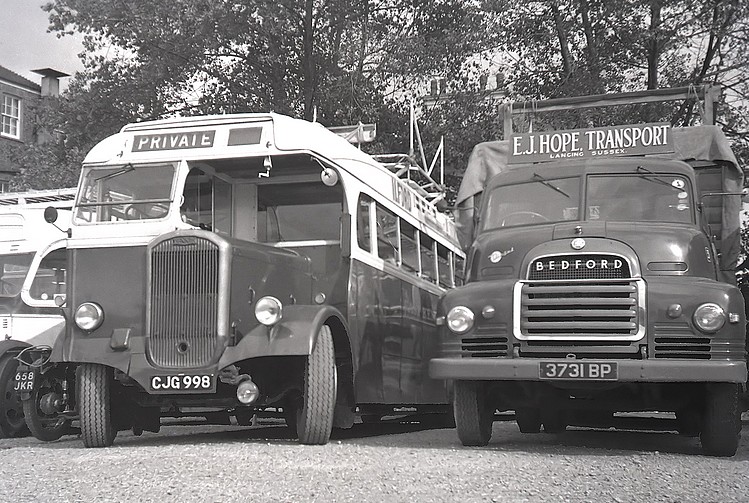
Popular around 1960 was the use of single deck buses and coaches in their twilight years to carry
rowing teams to regattas. Boat racks were mounted on the roof, and such vehicles could be seen at many coastal resorts in the
summer. Here 1948 Dennis Lancet CJG 998 is nearing the end of its career and has turned up at Eastbourne (Greencroft car park
near the sea front - now a multi-storey) on a sunny weekend in 1962, alongside one of the variety of other vehicles on similar
duties. The style of the Park Royal bodywork might be considered somewhat basic, but was typically East Kent. (Photo: Dick
Gilbert)
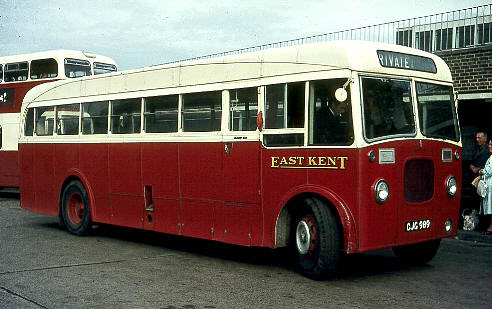
Cliff Essex kindly sent this fine picture of CJG 989 after its conversion to a full-fronted
design, one of only two in the batch to be modified in this way. Cliff thinks the picture was taken in Canterbury around 1968,
which would have been the very end of its working life.
- CJG 988 - Built 9/48, c/n 478J3, P.R.body No. B32675. Rebuilt to FB35F. Sold late 1967 to a dealer in Whitstable, then to a private owner in London.
- CJG 989 - Built 9/48, c/n 477J3, P.R.body No. B32676. Rebuilt to FB35F. Withdrawn 1968 and sold for scrap.
- CJG 990 - Built 9/48, c/n 480J3, P.R.body No. B32677. Withdrawn 1962. **SURVIVOR** but in poor condition. In Scotland 2001.
- CJG 991 - Built 10/48, c/n 481J3, P.R.body No. B32678. Sold 1962 to R.K.Packers, Grove Ferry, Kent.
- CJG 992 - Built 10/48, c/n 489J3, P.R.body No. B32679. Withdrawn 1962.
- CJG 993 - Built 10/48, c/n 490J3, P.R.body No. B32680. Withdrawn 1962.
- CJG 994 - Built 10/48, c/n 493J3, P.R.body No. B32681. Withdrawn 1962 and sold to Hythe Albion Social Club. Replaced by EFN 577 (below) in 1964.
- CJG 995 - Built 10/48, c/n 494J3, P.R.body No. B32682. Withdrawn 1962.
- CJG 996 - Built 10/48, c/n 495J3, P.R.body No. B32683. Withdrawn 1962.
- CJG 997 - Built 12/48, c/n 496J3, P.R.body No. B32684. Withdrawn 1962. Photo via Paul Redmond.
- CJG 998 - Built 12/48, c/n 497J3, P.R.body No. B32685. Rebuilt to FB35F (o. m. o.) in 1959. Withdrawn 1962.
- CJG 999 - Built 12/48, c/n 500J3, P.R.body No. B32686. Initially B32R allocated as a coach. Rebuilt to FB35F (o. m. o.) in 1959. Withdrawn 1963.<+li>
DENNIS LANCET III COACHES - EFN 571-595 (total 25)
Delivered April-June 1950
Chassis: Dennis Lancet III J3, with Dennis 6-cylinder diesel engine.
Body: Park Royal C32F halfcab, 27' 6" long. By 1961 EFN 583-595 were being used as buses/dual-
purpose (DP32F).
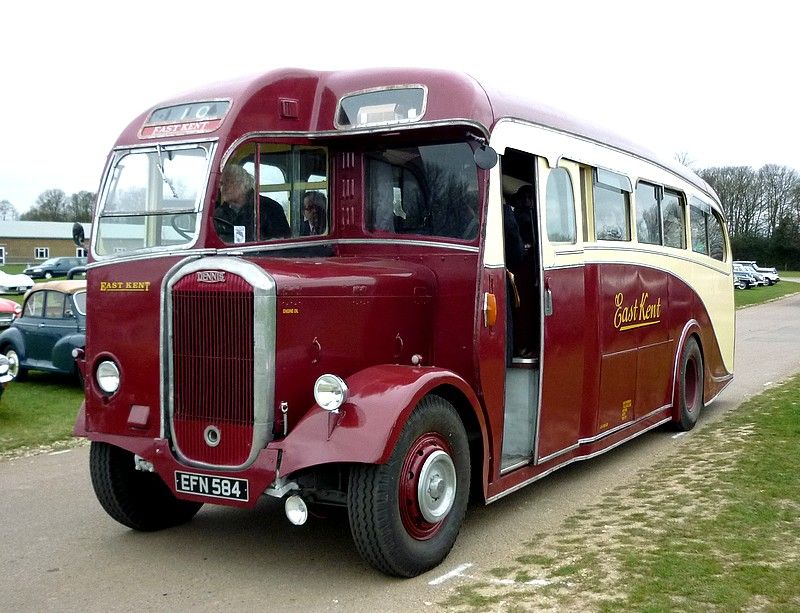
EFN 584 fresh from complete restoration, seen at the Detling rally in April 2012. Photo: Dick
Gilbert.
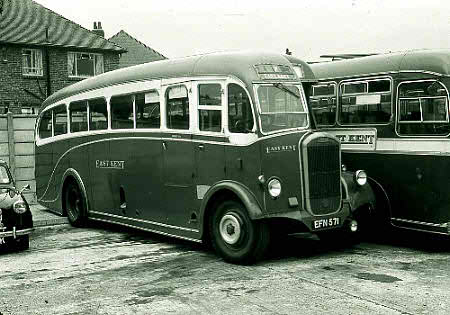
First of the 1950 batch of coaches was EFN 571, photographed here by Cliff Essex.
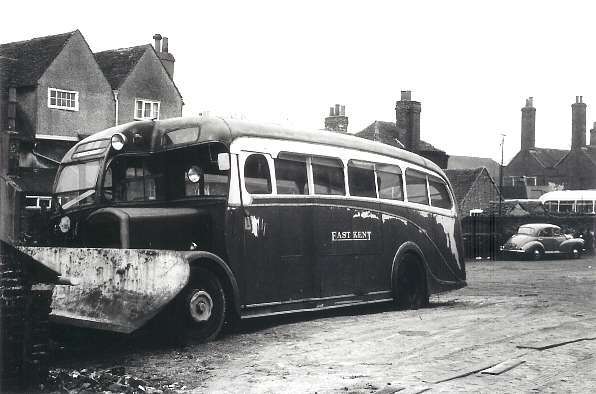
This could be EFN 587 or 588 at Herne Bay on 2 January 1969, in use as a snowplough. Photo by
Peter Esposito via Chris Stanley. Garth Wyver emailed to say that he thinks the location is actually the Central Works at Kirby
Lane/North Lane, Canterbury. Richard Wallace emailed in 2013 "Re the picture of the East Kent Lancet snowplough I can confirm that
it is EFN 587 and the location is Canterbury Central Works. I worked for East Kent in those days and its sister snowplough EFN
588 was based at Deal."
Notes: The entire batch were withdrawn from service in 1964.
- EFN 571 - Built 4/50, c/n 739J3, P.R.body No. B34303. Withdrawn Nov 1964.
- EFN 572 - Built 4/50, c/n 797J3, P.R.body No. B34304. Withdrawn end of 1964.
- EFN 573 - Built 5/50, c/n 795J3, P.R.body No. B34305. On hire to Butlins, Cliftonville in blue livery 1963-64. Withdrawn end of 1964. With Parham (Gillingham) contractor 1965.
- EFN 574 - Built 5/50, c/n 796J3, P.R.body No. B34306. Withdrawn end of 1964.
- EFN 575 - Built 5/50, c/n 810J3, P.R.body No. B34307. Withdrawn end of 1964. To T.H.Contractors, Aylesford, Kent 1965.
- EFN 576 - Built 5/50, c/n 811J3, P.R.body No. B34308. Withdrawn end of 1964. With Gillie, Aylesham, Canterbury 1965.
- EFN 577 - Built 5/50, c/n 812J3, P.R.body No. B34310. Withdrawn end of 1964 and sold to Hythe Albion Social Club, replacing CJG 994 (above).
- EFN 578 - Built 5/50, c/n 817J3, P.R.body No. B34311. Withdrawn end of 1964.
- EFN 579 - Built 5/50, c/n 818J3, P.R.body No. B34309. Withdrawn end of 1964.
- EFN 580 - Built 5/50, c/n 819J3, P.R.body No. B34312. Withdrawn end of 1964.
- EFN 581 - Built 5/50, c/n 825J3, P.R.body No. B34313. Withdrawn end of 1964.
- EFN 582 - Built 5/50, c/n 824J3, P.R.body No. B34315. Withdrawn end of 1964.
- EFN 583 - Built 5/50, c/n 826J3, P.R.body No. B34314. In use as a bus by 1961. Withdrawn end of 1964.
- EFN 584 - Built 5/50, c/n 832J3, P.R.body No. B34316. In use as a bus by 1961. Withdrawn end of 1964. **SURVIVOR**. Worthen Travel, Shrewsbury 2020.
- EFN 585 - Built 5/50, c/n 834J3, P.R.body No. B34317. In use as a bus by 1961. Withdrawn end of 1964. **SURVIVOR**. Steven Byrne, Onibury, Shropshire 2013.
- EFN 586 - Built 5/50, c/n 833J3, P.R.body No. B34318. In use as a bus by 1961. Withdrawn end of 1964.
- EFN 587 - Built 6/50, c/n 840J3, P.R.body No. B34319. In use as a bus by 1961. Withdrawn, but in use as a snow plough 1963-65.
- EFN 588 - Built 6/50, c/n 848J3, P.R.body No. B34320. In use as a bus by 1961. Withdrawn end of 1964. In use as a snow plough 1964-65.
- EFN 589 - Built 6/50, c/n 849J3, P.R.body No. B34321. In use as a bus by 1961. Withdrawn end of 1964.
- EFN 590 - Built 6/50, c/n 860J3, P.R.body No. B34322. In use as a bus by 1961. Withdrawn end of 1964. With Hawthorn Leslie Buildings (of Jarrow) 1965, working in Maidstone, and later in Newcastle.
- EFN 591 - Built 6/50, c/n 861J3, P.R.body No. B34323. In use as a bus by 1961. Withdrawn end of 1964. With Finn-Kelsey, Old Romney for staff transport 1965. **SURVIVOR** in poor condition and used as spares source for EFN 592.
- EFN 592 - Built 6/50, c/n 864J3, P.R.body No. B34325. In use as a bus by 1961. Withdrawn end of 1964, sold to Thomsett, Deal. **SURVIVOR**
- EFN 593 - Built 6/50, c/n 865J3, P.R.body No. B34324. In use as a bus by 1961. Had canoe racks fitted to roof around that time. Withdrawn end of 1964.
- EFN 594 - Built 6/50, c/n 871J3, P.R.body No. B34326. In use as a bus by 1961. Withdrawn end of 1964.
- EFN 595 - Built 6/50, c/n 874J3, P.R.body No. B34327. In use as a bus by 1961. Withdrawn end of 1964. With Sangwin (contractor), Hull 1965. Maybe later renamed Sangarius Plant Hire. Acquired 1974 for preservation by Weaver and Peterson. **SURVIVOR** Nick Wilkinson, Scarborough.
TOTAL 167
With ten Survivors (or partial survivors), JG 8720, CFN 121, CFN 136, CFN 154, CJG 990, EFN 584,
EFN 585, EFN 591, EFN 592 and EFN 595.
For more East Kent buses see the East Kent Leyland Tigers page.
For many other buses, have a look at all the other profiles on the Classic
Buses menu page.
SOME LINKS WITHIN THIS WEBSITE:
Home
Email
Links
THE COMPLETE WEBSITE MENU
Events Diary
Halfcab list
Small-Ads
Classic Irish Buses
Classic Manx Buses
SB


















